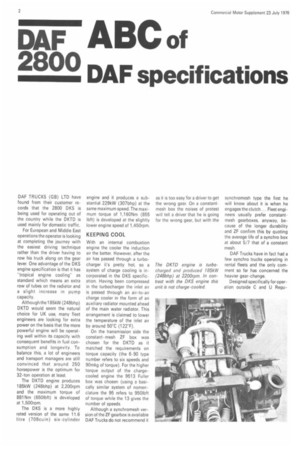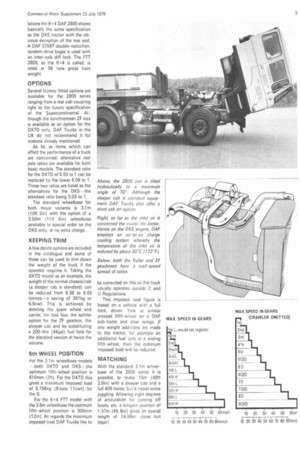DAF ABC of 28°° DAF specifications
Page 46

Page 47

If you've noticed an error in this article please click here to report it so we can fix it.
DAF TRUCKS (GB) LTD have found from their customer records that the 2800 DKS is being used for operating out of the country while the DKTD is used mainly for domestic traffic.
For European and Middle East operations the operator is looking at completing the journey with the easiest driving technique rather than the driver having to row his truck along on the gear lever. One advantage of the DKS engine specification is that it has "tropical engine cooling" as standard which means an extra row of tubes on the radiator and a slight increase in pump capacity.
Although the 185kW (248bhp) DKTD would seem the natural choice for UK use, many fleet engineers are looking for extra power on the basis that the more powerful engine will be operating well within its capacity with consequent benefits in fuel consumption and longevity. To balance this, a lot of engineers and transport managers are still convinced that around 250 horsepower is the optimum for 32-ton operation at least, The DKTD engine produces 185kW (248bhp) at 2,200rpm and the maximum torque of 881 Nm (650Ibft) is developed at 1,500rpm.
The DKS is a more highly rated version of the same 11.6 litre (7 0 8cu in) six-cylinder engine and it produces a substantial 229kW (307bhp) at the same maximum speed. The maximum torque of 1,160Nm (855 lbft) is developed at the slightly lower engine speed of 1,450rpm.
KEEPING COOL
With an internal combustion engine the cooler the induction air the better. However, after the air has passed through a turbocharger it's pretty hot, so a system of charge cooling is incorporated in the DKS specification. Having been compressed in the turbocharger the inlet air is passed through an air-to-air charge cooler in the form of an auxiliary radiator mounted ahead of the main water radiator. This arrangement is claimed to lower the temperature of the inlet air by around 50°C (122°F).
On the transmission side the constant-mesh ZF box was chosen for the DKTD as it matched the requirements on torque capacity (the 6-90 type number refers to six speeds and 90mkg of torque). For the higher torque output of the chargecooled engine the 9513 Fuller box was chosen (using a basically similar system of nomenclature the 95 refers to 950Ibft of torque while the 13 gives the number of speeds.
Although a synchromesh version of the ZF gearbox is available DAF Trucks do not recommend it as it is too easy for a driver to get the wrong gear. On a constantmesh box the noises of protest will tell a driver that he is going for the wrong gear, but with the The DKTD engine is turbocharged and produced 185kW (248bhp) at 2200rpm. In contrast with the DKS engine this unit is not charge-cooled. synchromesh type the first he will know about it is when he engages the clutch ... Fleet engineers usually prefer constantmesh gearboxes, anyway, because of the longer durability and ZF confirm this by quoting the average life of a synchro box at about 5/7 that of a constant mesh.
OAF Trucks have in fact had a few synchro trucks operating in rental fleets and the only comment so far has concerned the heavier gear-change.
Designed specifically for operation outside C and U Regu
lations the 6 x4 DAF 2800 shares basically the same specification as the D KS tractor with the obvious exception of the rear end. A DAF 2255T double-reduction, tandem-drive bogie is used with an inter-axle diff lock. The FTT 2805, as the 6x4 is called, is rated at 56 tons gross train weight.
OPTIONS
Several factory-fitted options are available for the 2800 series ranging from a rear cab coupling light to the luxury specification of the Supercontinental. Although the synchromesh ZF box is available as an option for the DKTD only, DAF Trucks in the UK do not recommend it for reasons already mentioned.
As far as items which can affect the performance of a truck are concerned, alternative rear axle ratios are available for both basic models. The standard ratio for the D KTD of 5.53 to 1 can be replaced by the lower 6.09 to 1. These two ratios are listed as the alternatives for the DKS —the standard ratio being 5,03 to 1.
The standard wheelbase for both major variants is 3.1m (10-ft 2in) with the option of a 3.50m (lift 6in) wheelbase available to special order on the DKS only, at no extra charge.
KEEPING TRIM
A few delete options are included in the catalogue and some of these can be used to trim down the weight of the truck if the operator requires it. Taking the DKTD model as an example, the weight of the normal chassis/cab (a sleeper cab is standard) can be reduced from 6.38 to 6.03 tonnes—a saving of 351kg or 6.9cwt. This is achieved by deleting the spare wheel and carrier, the tool box, the splitter option for the ZF gearbox, the sleeper cab and by substituting a 200-litre (44ga1) fuel tank for the standard version at twice the volume.
5th WHEEL POSITION
For the 3.1m wheelbase models —both DKTD and DKS—the optimum fifth-wheel position is 610mm (2ft). For the DKTD this gives a maximum imposed load of 9,758kg (9 tons 11cwt) for the S.
For the 6 x 4 FTT model with the 3.6m wheelbase the optimum fifth-wheel position is 300mm (12in). As regards the maximum imposed load DAF Trucks like to be consulted on this as this truck usually operates outside C and U Regulations.
This imposed load figure is based on a vehicle with a full tank, driver, York or similar pressed fifth-wheel on a DAF sub-frame and steel wings. If any weight additions are made to the tractor, for example an additional fuel tank or a sliding fifth-wheel, then the optimum imposed load will be reduced.
MATCHING
With the standard 3.1m wheelbase of the 2800 series it is possible to make 15m (49ft 2.6in) with a sleeper cab and a full 40ft trailer, but it needs some juggling. Allowing eight degrees of articulation for coming off boats, etc, a kingpin position of 1.37m (411 6in) gives an overall length of 14.98m close but legal!
















































































































